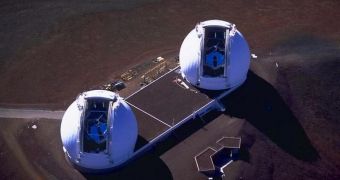Astronomers have known for quite some time that the core of large galaxies across the Universe host impressively large, supermassive black holes, behemoths of the skies with millions of times the mass of our own Sun. Now, with the help of the twin W. M. Keck Observatory telescopes, scientists at the University of California in Santa Barbara (UCSB) have managed to identify no less than four such black holes at the core of their respective galaxies. The instruments are located at an altitude of about 4,145 meters (13,600 feet) above sea level, atop Mauna Kea, in Hawaii.
Experts say that the black holes are usually referred to as active galactic nuclei (AGN) when in their galactic configurations. For the first time ever, the two instruments were able to distinguish an AGN quasar as part of the group of four galaxies that were a part of the new study. The group is located more than one billion light-years away from our planet, but they could easily be resolved with the Keck. The two observatories make up the largest optical/infrared telescope in the world today. The team behind the study also used the United Kingdom Infrared Telescope (UKIRT) to gather more data in the infrared portions of the electromagnetic spectrum.
“Astronomers have been trying to see directly what exactly is going on in the vicinity of these accreting super-massive black holes,” UCSB astrophysicist Robert Antonucci explains. He is also the coauthor of a new study detailing the findings, which appears in the December 1 issue of the respected scientific journal Astronomy and Astrophysics. The new investigation, he says, also allowed scientists to separate emissions coming from the AGN into two separate categories – those generated in the vicinity of the accretion disks, and those generated closer to the surface of the black holes themselves.
The new observations were only made possible by the special layout of the Keck components. The two instruments are separated by 85 meters of free space, and can be used in block, as an interferometer. This means that they can both act as if they were a single telescope, with a 85-meter lens. This allows for a wealth of details to be observed at distances previously inaccessible to ground-based observatories. The advanced instruments are a scientific partnership between the California Institute of Technology (Caltech), the University of California, and NASA. Each telescope lens is ten meters in diameter.

 14 DAY TRIAL //
14 DAY TRIAL //